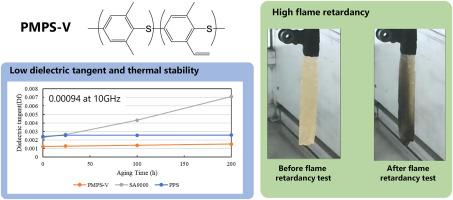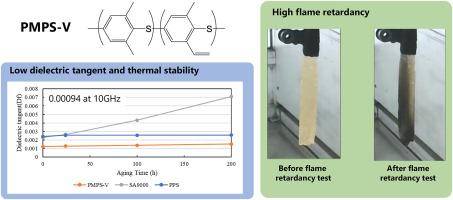Novel polyphenylene sulfide resin for high-frequency copper-clad laminates with low dielectric tangent and flame retardancy
IF 4.5
2区 化学
Q2 POLYMER SCIENCE
引用次数: 0
Abstract
We report a novel poly(2,6-dimethyl-1,4-phenylene sulfide) resin bearing vinyl groups (PMPS-V) designed for next-generation copper-clad laminates used in high-frequency applications. Oligo(2,6-dimethyl-1,4-phenylene ether) resins are commonly used owing to their low dielectric constant and high thermal resistance; however, further reduction in dielectric loss tangents is needed for future communication networks. Materials with excellent dielectric properties typically exhibit low polarity and high flammability, presenting a trade-off between dielectric performance and flame retardancy.
PMPS-V exhibits thermosetting behavior and an extremely low dielectric-loss tangent (<0.001 at 10 GHz). Owing to its polyphenylene sulfide backbone, PMPS-V meets the UL-94 V-0 flame retardancy standard. Long-term heat resistance testing at 150 °C confirmed minimal degradation in dielectric properties, demonstrating excellent thermal stability. In addition, PMPS-V has a high glass transition temperature and favorable solubility in common solvents such as toluene, making it suitable for printed wiring board applications. These results indicate that PMPS-V is a promising candidate for next-generation low dielectric materials.


新型低介电正切阻燃高频覆铜层压板用聚苯硫醚树脂
我们报道了一种新型的含乙烯基的聚(2,6-二甲基-1,4-苯硫醚)树脂(PMPS-V),设计用于高频应用的下一代覆铜层压板。低聚(2,6-二甲基-1,4-苯基醚)树脂因其介电常数低、热阻高而被广泛使用;然而,未来的通信网络需要进一步降低介质损耗切线。具有优异介电性能的材料通常表现为低极性和高可燃性,呈现出介电性能和阻燃性之间的权衡。PMPS-V表现出热固性和极低的介电损耗正切(10 GHz时<;0.001)。由于其聚苯硫醚骨架,PMPS-V符合UL-94 V-0阻燃标准。在150°C下的长期耐热性测试证实介电性能的最小退化,表现出优异的热稳定性。此外,PMPS-V具有较高的玻璃化转变温度和在甲苯等常见溶剂中的良好溶解度,使其适用于印刷线路板应用。这些结果表明PMPS-V是下一代低介电材料的理想候选材料。
本文章由计算机程序翻译,如有差异,请以英文原文为准。
求助全文
约1分钟内获得全文
求助全文
来源期刊

Polymer
化学-高分子科学
CiteScore
7.90
自引率
8.70%
发文量
959
审稿时长
32 days
期刊介绍:
Polymer is an interdisciplinary journal dedicated to publishing innovative and significant advances in Polymer Physics, Chemistry and Technology. We welcome submissions on polymer hybrids, nanocomposites, characterisation and self-assembly. Polymer also publishes work on the technological application of polymers in energy and optoelectronics.
The main scope is covered but not limited to the following core areas:
Polymer Materials
Nanocomposites and hybrid nanomaterials
Polymer blends, films, fibres, networks and porous materials
Physical Characterization
Characterisation, modelling and simulation* of molecular and materials properties in bulk, solution, and thin films
Polymer Engineering
Advanced multiscale processing methods
Polymer Synthesis, Modification and Self-assembly
Including designer polymer architectures, mechanisms and kinetics, and supramolecular polymerization
Technological Applications
Polymers for energy generation and storage
Polymer membranes for separation technology
Polymers for opto- and microelectronics.
 求助内容:
求助内容: 应助结果提醒方式:
应助结果提醒方式:


